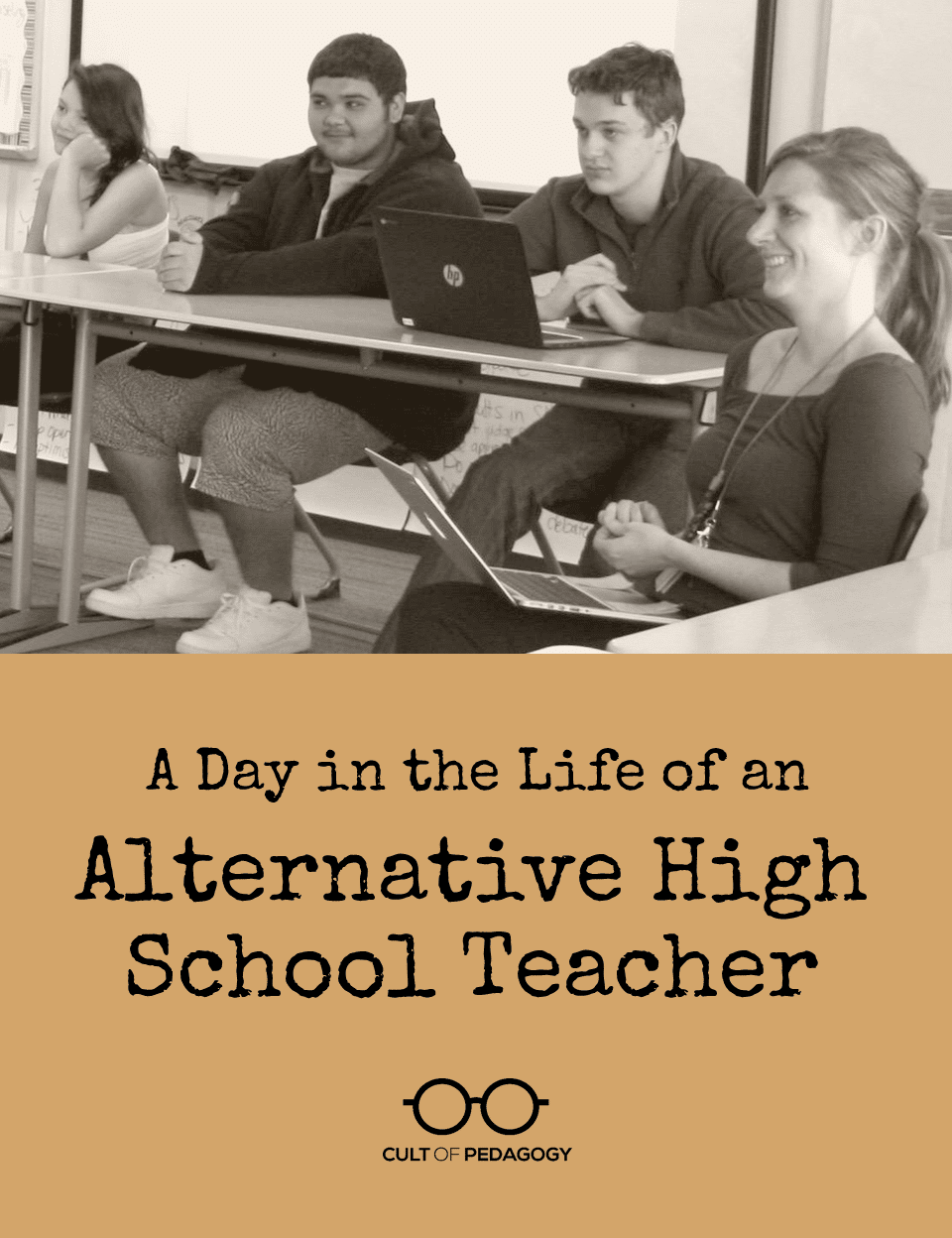
What everyone really wants to know is if I teach THOSE kids—the mean ones, the dangerous ones, the ones that are “too far gone to save.”
I hold my ID over the buzzer and see the sun peeking over the roof of our building; it’s my last chance to regroup my brain before the day begins. As I round the corner into my hallway, I see students seated in hubs we have around the school and greet them with a smile, even though I don’t feel particularly bubbly at 7:30 a.m. Most return the smile, a few will say “good morning,” and sometimes all I get is a small nod in return. I’ll take it. They’re only slightly zombie-fied, some with McDonald’s breakfast and others sipping their caffeine of choice. Headphones placed over their heads—the big ones, covering their ears like ear muffs—they let out big laughs at whatever the current Internet video brings out of them.
Welcome to (alternative) high school.
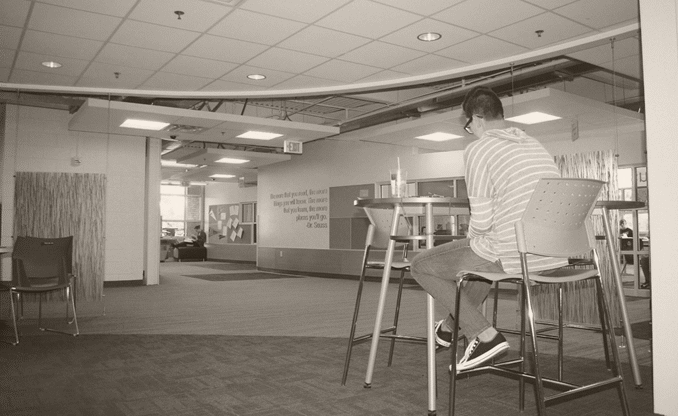
A student reads in one of the collaborative spaces in our
newly-remodeled building, designed by teachers and students.
As I write this, I’m just getting into the thick of the year—the newness is starting to wear off and the haggardness is starting to set in, as almost every teacher knows to be true of the end of the honeymoon period. When someone asks me what I do (typically at big social gatherings where small talk is rampant), I hate how limited “I work at an alternative high school” sounds. The person pauses and tilts her head, trying to think of a tactful way to ask what she’s actually thinking. It comes out as “Oh, what does alternative mean?”
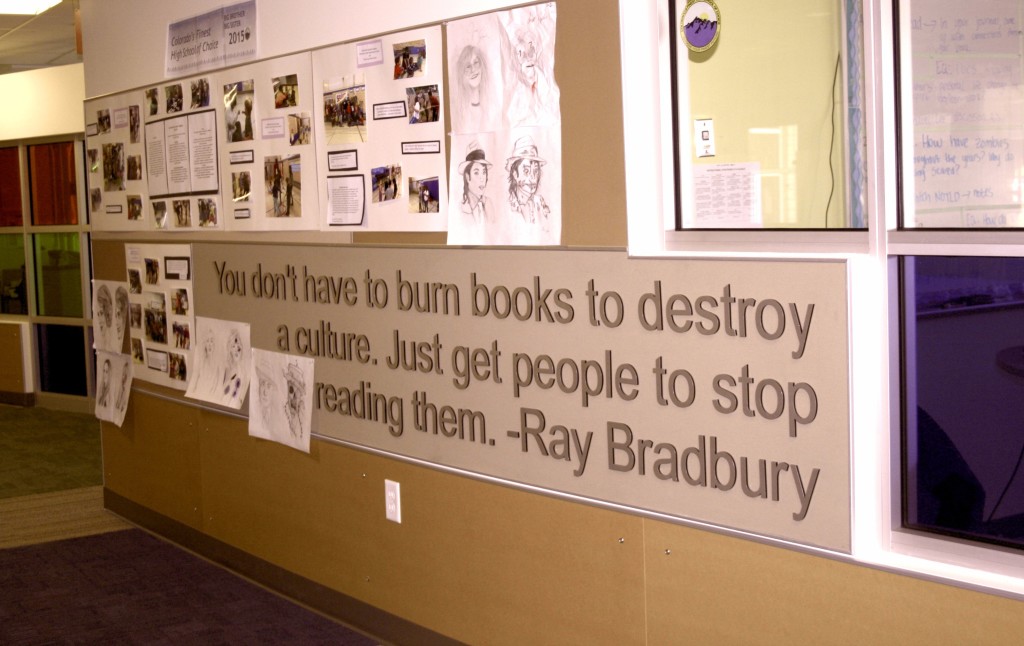
Quotes cover the exterior “walls” of our classrooms—this is one from the English hallway.
Teachers chose the quotes while the building was being remodeled.
What everyone really wants to know is if I teach those kids—the mean ones, the dangerous ones, the ones that are “too far gone to save.” I’ve learned that the word “alternative” can mean different things to different people, so I have perfected an elevator speech. It goes like this:
“Our school has been around for about 30 years, and we offer a place for students to learn in a non-judgmental and caring environment. Students do not have letter grades but have points they earn for each class every day. If they do not demonstrate their learning, they do not get their point. Teachers have a group of students called a ‘family’ that they are with until they graduate. Teachers act as counselors for their students, advocating for them in all stages of their high school career.”
Even that is too mechanical, too rehearsed, and almost painful: I know it is only skimming the surface of the vast history and culture of our school.
What I want is to show the work that our school does, to add depth to the term “alternative.” A passion of mine, and of many other teachers, is to share the stories that fit into the one big story of public education—especially when so many others tell our story, terribly, for us and without our permission.
So, let me get started with the structure of our program.
The Curriculum
Courses are offered in six-week blocks; a full school year is comprised of six of these sessions. Teachers get to choose which classes we will teach for each session, and students are free to choose their own classes.
This autonomy for teachers (and students) with the schedule is crucial. Whatever I believe needs to be taught, along with my department, is what I teach. For example: I noticed that our students would connect really well to the thoughts and ideas of the Transcendentalists, so I taught a class on that. I put it on the schedule, and the students elected to take it for part of their American Literature credit needed to graduate. If they didn’t think Transcendentalism was going to be something they could engage with, they took a different class. It’s similar to the way college students select their classes.
Course offerings for one 6-week session.
(Click to open a larger view.)
This flexibility allows teachers to create curriculum that is relevant, essential, and engaging to our students, as long as it is connected to Common Core standards. Classes that have been taught in the past include: Designing a LEED-certified greenhouse (STEM), Serial Podcast (Am. Lit/Elective), Yoga (Health/PE), and The History of Terrorism (World History). Imagine a school where nearly each student has choice and is excited about what they are learning. They are not “sent” here; they are not “put” in classes. Of course, sequential and required classes such as math are not as flexible, but a student can choose when they take math (for example, if they are groggy in the morning and would perform better in the afternoon, they have the ability to make that decision).
The flexibility and authenticity of our schedule is something that drew me to teaching here. And you won’t find the typical grading system you would see in a high school; instead, we have a point system. This is where I lose most people in my elevator speech.
The Point System
A key part of our school is points—not grades. Students must have 90 percent of their possible points to stay in good standing in the school. To get their point for every day, they must be present and must demonstrate their learning in whatever way the teacher is planning that day; whether it’s a quiz, a project, writing, a reading assignment, or some other activity. This system puts the onus on the student to engage and learn.
Points also provide effective feedback about student behavior. If they are doing things that interfere with their learning—such as being on their cell phones, chatting too much, or being off-task—they do not earn their point for the day. They do, however, have the opportunity to earn the point back the next day.
With the card, two signatures per day per class equals one point. At the bottom, there is the total for 90 and 100 percent. Students are responsible for knowing if they are or are not at 90 percent. Any other symbol below it means they are going to make the point soon (quiz, project, etc.). There are also disciplinary symbols (“SO,” which you see on this card, means the student “sat out” or did not participate). Students have the opportunity to make these back in the time given.
Students carry a point card with them throughout the day.
The A stands for attendance, and the P stands for participation.
With this model, every day students are making points to graduation. For many of them, taking it one day at a time helps them see the big picture of eventual graduation. Seeing the amount of control they have over their education—for better or worse—is one gigantic paradigm shift.
My Daily Schedule
For my schedule, I teach straight through the morning into the period following lunch. I’m an English teacher, primarily writing, but I cover everything from 9th to 12th grade. I teach six classes a day, and I feel privileged to work with the students I do. Because our school attracts students from all areas and levels, I have a lot of differentiation on my hands. In any given class, I could have one student who reads at a 7th grade level, and another who reads a college level. This is fairly normal for our program, which is why class sizes under 22 students are necessary.
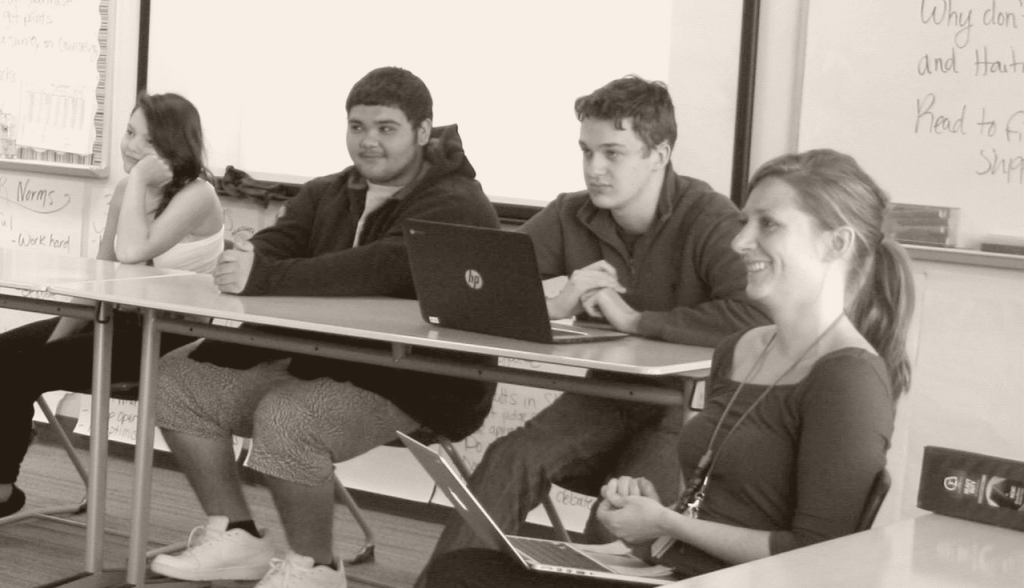
That’s me with part of a debate team for my argumentative writing class.
We were debating whether the drinking age should be lowered to 18.
After lunch comes family, a kind of advisory period when we update students on what’s going on—special schedules, registration, college visits, etc. It’s also a time to bond and do some team building. Many schools struggle with things like cohesiveness in school culture. In ours, the culture and connectedness of our school is driven by family. Each family has about fifteen students per teacher, and meeting times are about 25 minutes long.
The responsibilities of being a family teacher include registering students for classes, calling parents, and staying in constant communication with students, helping them work through personal and social issues, and performing interventions. Students stay with the same family teacher throughout their four years at our school, so when the time for graduation comes, the family teacher is the one to hand students their diplomas. Currently I have about five seniors—my year will be busy writing letters of recommendation, making sure they have applied to college, and filling those gaps before they leave.
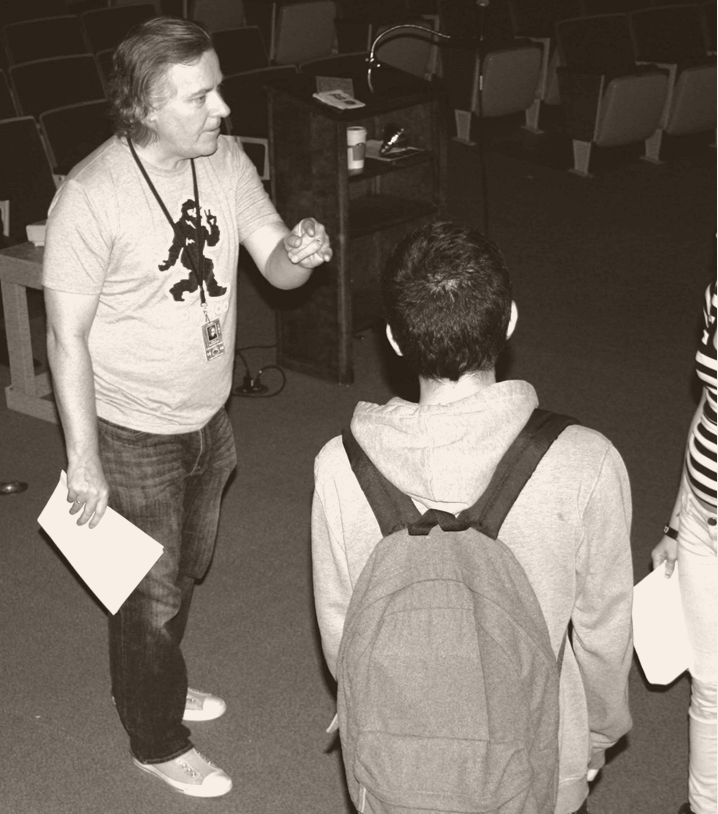
Students take direction from the drama department’s director.
The last class I help teach is drama. We are fortunate to have a program that we just started this year. So far, we have put on one student-written and student-produced play called A World Gone Mad, a mashup of fairy tales. My role is to assist the director in anything that needs being done—attendance taking, managing students, logistics, and to be an extra set of eyes.
After this class is over, I’m done teaching for the day. The last couple of hours are for handling any issues within my school family, attending staff meetings, and fitting in some planning time if I’m lucky.
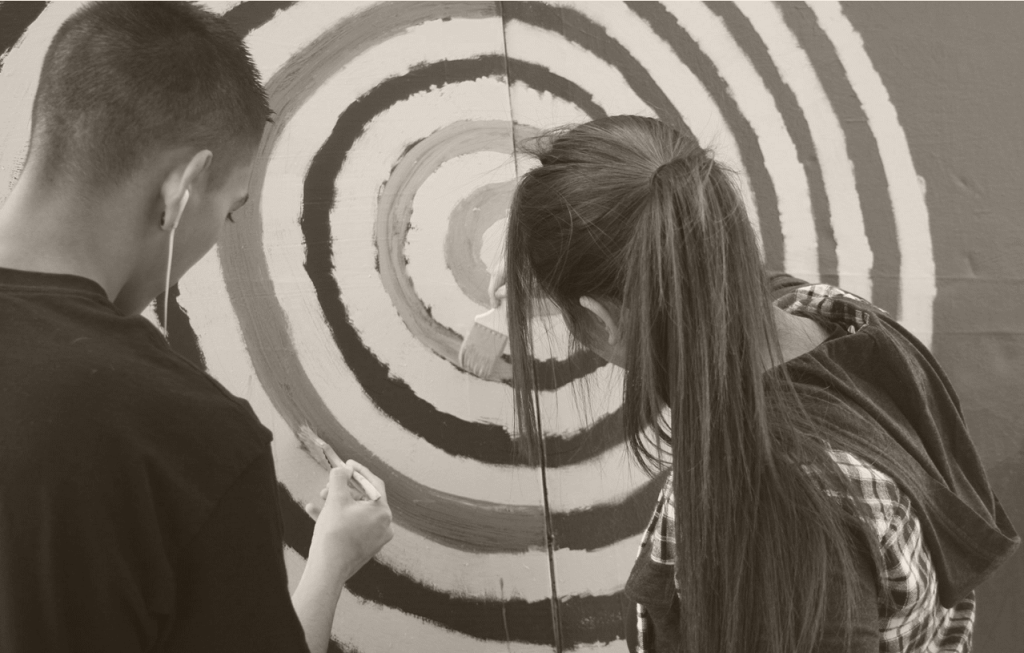
Students paint a backdrop for an upcoming drama production.
When Problems Arise
On this particular day, I’m giving up some needed planning time to attend a meeting called an “Appeals” for a student who got into a verbal altercation with another student, which breaks one of our three golden rules—no anti-social behavior, make 90 percent of points, and no drugs or alcohol.
The student sits in the conference room, tense. She is staring at the table. A group of teachers trickle in (whoever was involved or wants to be there, plus the family teacher) to serve as part of the appeals board. They make casual conversation to lighten the mood—usually about something funny that happened to them, or the weather. Someone is tapping their pencil.
The meeting gets started with one question: Tell us why you’re here today.
The student begins quietly with her explanation; she’s remorseful. We learn that she’s been working late into the night so she can save money to move out of her house. It’s not a place she wants to be. She’s angry at herself, but she apologizes. The teachers make notes, ask more questions, offer her encouragement. Ultimately, the student must make the case to us that she can stay in good standing with our program if we let her come back. She insists that she will. She’ll be at 90 percent—100 even—and will not have any more broken golden rules. If she does, she’s not a student at our program.
This accountability piece—that students must show their willingness to succeed and control their actions the best they can—is crucial. They see attending as a privilege that is not guaranteed. They have to work, and in turn we work just as hard—and then some—to make sure they have best opportunities they can once they leave.

Art is a large interest for many of our students—our school and students have won
many local and national awards. These particular pieces are foil etchings.
We allow her to return, provided she does not have any more broken golden rules. The mood is lighter; a small smile returns to her face. We ask her some other questions—How’s your mom? Is your car running OK? We tell her we’re excited to see her back next week. She knows she’s lucky; not all students return if they are on an appeals.
The End of the Day
After the meeting is over, I’m exhausted. These meetings reveal so many underlying things about our students—abuse, addiction, family problems, medications, insecurities, strengths, interests, dreams—and it does take an emotional toll. I reluctantly stand up, stretch my legs, and head to my office. Once there, I muster some motivation to use the remaining day to do the things we all have to do—call parents, answer emails, give feedback on assignments, and decide my personal favorite: “What am I teaching tomorrow?”
It’s a good exhaustion. The kind that makes my body feel heavy and my head swim with all the thoughts propelling me to tomorrow—dreading it, but also hungry for learning more about myself, about teaching, about my students. I wouldn’t be anywhere else. ♥
Join the Cult of Pedagogy mailing list and get weekly tips, tools, and inspiration—in quick, bite-sized packages—all geared toward making your teaching more effective and fun. To thank you, you’ll get access to our Members-Only Library of free downloadable resources, including 20 Ways to Cut Your Grading Time in Half, which has helped thousands of teachers spend less time grading!

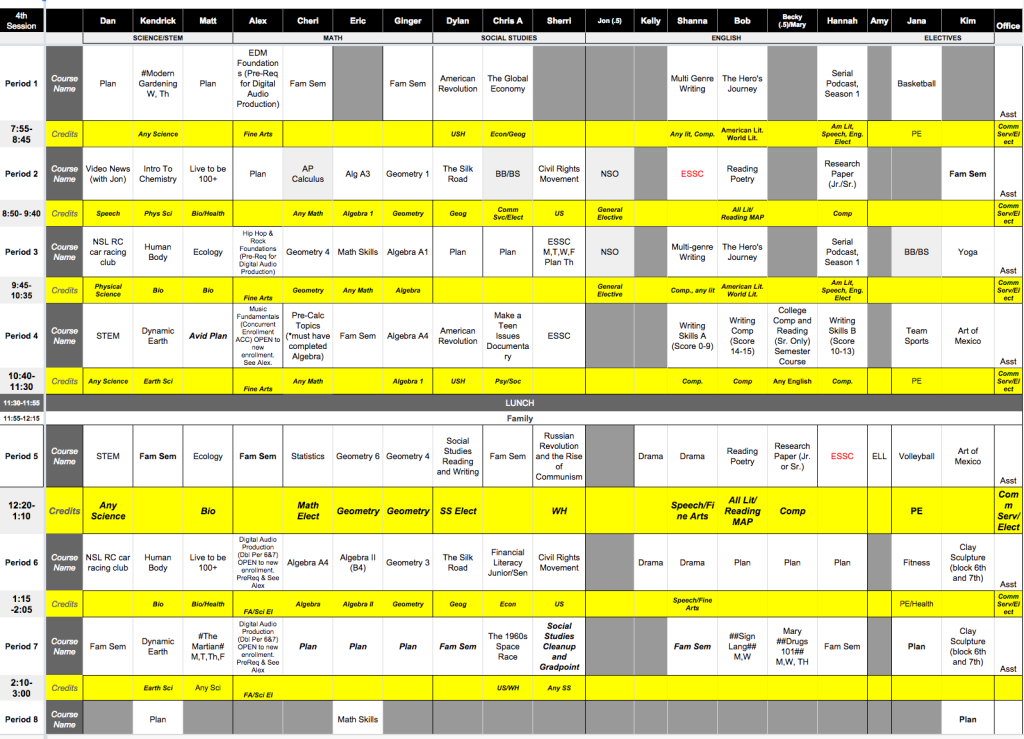
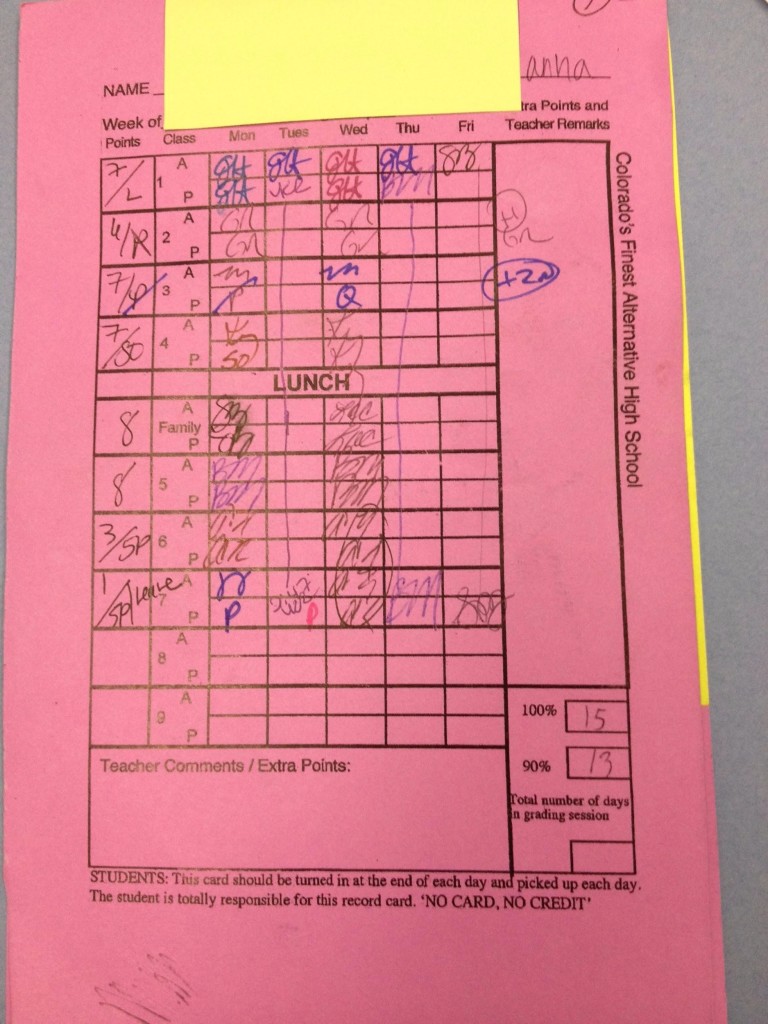




I really enjoyed this post until I got to the appeals section. Of course this feels different than many alternative high schools; like certain charter schools that boast high rates of success on multiple variables, this school is able to maintain a successful program through counseling out students who are not conforming. A student being removed from classes for a verbal altercation with the possibility of being counseled out of the school? A verbal altercation! My heart hurt a little bit for all of the students who have been pushed out of this, possibly last hope program, for “anti-social” behavior. It sounds like this place is willing to support students that had previous struggles, and give them a second chance, but only if they aren’t having current emotional or social troubles.
I too would like a response to the above comment.
I can see this model of alt Ed working successfully for the majority or plurality of students. We have severe attendance issues at my school… And the documentary Bad Kids seems Pollyannaish when I think about the challenges our students face.
Thanks!
Hi Brook! Thank you so much for reading. Something I think that is missing from the appeals section is that we work very closely with students to ensure that they’re developing coping mechanisms and getting what they need. Believe me—we have so many students with social and emotional troubles (don’t all schools?) And we have wonderful counselors and social worker that are constantly connecting. We rarely kick students out because of an incident or sometimes even compounded incidents. We’re a public high school and it does not operate like no-nonsense charters. However, upholding the culture of our school is important to us and to the other students. Appeals is not about getting pushed out of the program, but is a time to hear about what’s going on in the student’s life, to figure out how to support them, and get them in a state where they can learn, and show them how they can make amends. If you have used or read about restorative justice, we use a lot of language from that during appeals. I hope that sheds some more light. Thanks again for reading!
Just a friendly reminder that charter schools are all public schools too! There are a variety of approaches but they are all public entities offering more great choices to fit the needs of our student population !!
What degrees do you have? I am currently going back to school for my masters, but want to work in an alternative school. I want to make sure I am getting a degree that will be most beneficial. I have a bachelors in psychology. I was thinking masters of education, a masters of psychology, or school psychology. Any advice would be great! I admire what you do. I was once one of those troubled teenagers and I want to be able to give back and help allow these kids that there is so much out there for them and that they are capable of being great.
Hello! Thanks for reading and for deciding to become a teacher, particularly in an alternative program—your own experience will be so important for you and your students! I have a Bachelors in Language Arts Education, and preparing to begin a Masters in Curriculum and Instruction. I have a traditional teacher prep degree. Nowadays there are multiple pathways to obtain a teaching or counseling license, though I don’t really know the ins and outs of that. Each state is different in what they require. Good luck!!
Whoops, typo: I am preparing 🙂
Did you find a straight path to teaching kids who are struggling to maintain participation at a regular high school? I too, as one of those kids, now I would like to help others.
Matthew, I lucked into the alternative school world with my first position at a different school, which was a small alternative charter. I knew from that point that I did not wish to teach in a traditional environment. I suggest preferencing an alternative school for your student teaching placement and see how you like it! But don’t forget that at any school, you’ll be able to find and connect with students who are struggling. Good luck!
Hello I work for at Alternative School and this is my first year. I love it but it is a challenge daily because the student can be one way and the next day it can be totally different. I ask everyday how can I help these students to get to the point where they need to be. I am not in it for the money because they can’t pay me enough but it is my passion.
I am 15 years old and I am starting to become interested in life after high school. I am really interested in working at an alternative high school in the future but I have no idea how to get there. I want to go to college but I don’t know what I crudencials I would need to become a teacher or counselor at these schools. I want to learn about addiction, family issues, mental issues, and abuse and how to help people deal with these issues. Is there any advice you could give me reguarding how I can go about this? Thank you so much!
As a previous student and now a teacher (at another school) I can say the systems at this school work! I both sat on the appeals board as a student representative as well as was on an appeal myself. This process gives students a chance to take their mistakes seriously, have accountability for their actions, and make better choices. This school saved my life and my future. As a student at this school you truly feel how much your teachers care about you. At a “traditional” school I always felt overlooked, left behind and un-noticed. I had terrible family issues and the teachers at the alternative really cared about why I was having a bad day or why I seemed depressed. I loved my experience there and I know many others did as well!
Thank you for commenting! So cool and powerful to hear a former student (and now teacher’s) experience!
Sarah–so great to hear from you and so proud of all you’ve accomplished!!! I passionately believe in our program because I’ve watched it work miracles for 17 years. As you know, we don’t give you fish; we teach you to fish–put you in charge of your education, and that makes all the difference. Thanks for weighing in!
I very sincerely doubt you have even a fraction of the whole picture with respect to how they run “appeals”. It’s called restorative practices and/or restorative justice. I would be willing to bet, without many specifics because I work in a similar program, most students faced with “appeals” are retained. The dissection of a problem and dealing with it head-on works and can be backed up by data as an alternative to expulsion, suspension or even detention. It takes far more effort from all parties to learn about a problem and deal with is rather than simply punish students. All I am saying is I wouldn’t be so suspicious and rush to judgement on your interpretation of a word which likely has VERY different meaning within that specific program.
The mission is to try to salvage young people. “Anti social behavior”, it going happen. mitigate it and move on.
As a career marine, one thing we learned in mountain warfare training center, is leadership, in the mountains when marines are tired, and the weather is hot, movements long, and missions seem almost impossible. Getting marines to do what needs to be done; They had a saying:
“You can lead a horse to water, but he won’t drink, you can push his head under water, but still he may not drink, you can shove a straw up his butt, syphon it, and still he may not drink, but your job remains to make him drink, so get it done.”
What an amazing and wonderful experience you provide for those kids. Kudos to you! I would love to teach in that environment.
Dear Shanna, I loved your post. I have applied to work with the California Youth Authority as a HS Life Science teacher in an alternative setting; building relationships and helping students become better human beings is a prime foundation of how I teach, and the job description for the position reflects a lot of what your post addresses. Thank you for taking some of the mystery out of what you do…it makes the job even more attractive to me. THANK YOU! You are facilitating the redemption and growth of very important human beings, one individual at a time. Thank you again, for what you do every day.
Thank you for commenting! Relationships are crucial, period. Best of luck to you!
I also work in an alternative school and love the flexibility in your schedule. I’d love to see if we can implement something similar. We have teamed up with Think:Kids (www.thinkkids.org) to alter the philosophy and approach we use to work with our kids with challenging behaviors. Collaborative Problem Solving and Plan B conversations have been game-changers! The best part is that the main focus is on proactive work rather than reactive interventions. Feel free to email me if you want more information! Lodumtucker@gmail.com
I really enjoyed this article. Thank you for sharing!
Hi Shanna: I really enjoyed your post. I too teach in an alternative education program in Ontario, Canada. My students are similar to yours – behavioural, suspended or expelled. I see many similarities in our program and some new ideas to try. Thanks!
I teach in an alternative high school that seems to have some strong similarities. However, we do not have the option, except in extreme cases, to deny a student the right to return to our public school. I can see how an alternative school would benefit from the perception of attending bring a privilege versus a right. However, I’m not sure how this works legally or morally. (This sounds more aggressive than intending, but I’m struggling with wording). Where do students go to earn their high school diploma if they do not earn the right to return? Are you able to help transition them to another option?
The decision to not return for non-violent behavior is a collective decision (as in, if the student is not earning enough points for various reasons, which will delay their graduation, so they choose to attend another program). If students are expelled due to violent behavior or carrying a weapon, they have an expulsion hearing. Legally, students can re-enroll the next year per the expulsion legislation in Colorado law. Not sure how it works in your state, but that’s how it is in Colorado.
To answer your transition question, our counselors help them find a school either in their home district or at the other high school in our district. There’s also an online program that meets half-days in a brick and mortar building if students are having trouble staying the whole day for various reasons. There are also other career technical programs they may do.
Hi Shanna! I’ve just begun teaching at an alternative high school in rural Idaho. Do you have any suggestions for readings that address how to successful teach ELA in an alternative school? Any other suggestions you have for getting engagement from your students are welcome.
-Jaime
Hi Jaime! As far as ways to engage students, I suggest letting them weigh in on what they’d like to learn. I really have never had any success with the big literature textbooks—you know the ones. One of the most successful projects I did with my students about four years ago was I had them formulate a question about their city, and then try to solve it by doing research, interviews, etc. They were allowed to present their research in whatever way they wished. Any time you can make the content a co-decision with you and your students, you’ll find that they have a ton of buy-in and ownership. Check out this article about choice in reading: https://www.thoughtco.com/reading-choice-and-motivation-4135606. Good luck!
Hi Shanna,
Would it be ok if I used the attendance/course tracker form in my program? Thanks.
Sandra
can i go to this school? i started high school already, i’m in 9th grade. homecoming is soon though (3 weeks away) and i wanna stay until then 🙂 but after that, can i start going to this school?
Hi Aurora! I guess if you live in that area of the country, then maybe you can contact the people in charge and find out. We were just sharing with people what it’s like inside a school like that, but we don’t have any say in whether or not people get in so you should just contact them if interested. Best wishes!
Hello!
I am a new teacher (biology) at an alternative high school. I am also a new teacher in general (this is my first year teaching). Honestly, I feel overwhelmed. I am having trouble figuring out how I want to design my curriculum and approach material for the students. They are very easily frustrated and distracted (which is somewhat expected), and I simplify the material quite a bit, I try to implement hands on activities and media, but I still don’t feel like I’m reaching them. Do you have any tips or resources to help me adjust my approach to content?
Thank you!
Hi Kalee,
Teaching is overwhelming and even moreso for a new teacher. There’s all kinds of reasons why kids get distracted or frustrated, so there’s a lot we need to consider. Here are some resources to check out: Understanding by Design, Dogfooding: How Often Do You Do Your Own Assignments?, and 5 Questions to Ask Yourself About Your Unmotivated Students. See if something here jumps out at you — hope it helps!
Mostly it comes down to the relationship you build with your learners. Focus as much as you can on what interests they bring to your class and take an interest in them. Don’t take stuff personally and make sure you have an hobby/ pastime/ life outside school.
Hello! I am interested in the various careers available in alternative education because of my own experiences in continuation school. Could you please tell me what your and your colleagues credentials are? I am curious about the level of education most faculty have working at alternative schools.
Thank you!
HI Carleigh! Unfortunately, this is such an old post that we’ve lost touch with the guest writer. However, we did find this one article that you might find helpful: What to Know About Teaching at an Alternative School.
911!
EMERGENCY!
URGENT!
Hello! My name is Jennifer and I am the Lead Teacher here at our alternative school. I’ve been here for 22 years! Our building is so old and dilapidated! Fortunately, this summer we are SUPPOSED to get the building renovated—-entire interior gutted, new roof, and outside redone. The building dimensions are 28’9″ x 48′. There are 2 teachers here. I want us to have our own individual classroom. Also, I want 4 restrooms (girls, boys, male teacher, and female teacher), small office for me, decent storage closet, water fountain, small computer area, small coffee station area (kitchenette for microwave, small fridge, etc.). I’d like to have a back exit door, as well. I know it’s a lot to cram into this limited space, but I know it can work! LOL!!! I can send pics of what everything currently looks like inside, if needed. The student population ranges up to a max of 8 kids for each teacher here. We are a small school district. Please help! Any ideas? Please!!! Desperate!! THANKS IN ADVANCE!!!
Hello! Would you mind sharing the layout of your school building and classroom (and floor plan, please)? I’d love some ideas. Our 28’9″x48′ alternative school building is being completely gutted inside for renovations this summer. Thanks!
Hi, Jennifer! Unfortunately, this is such an old post that we’ve lost touch with the guest writer. Other readers of this post who work in similar settings might have some ideas to share, though!